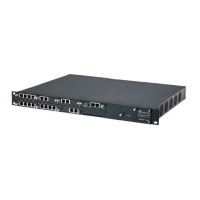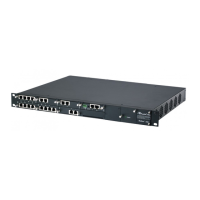Version 7.2 435 Mediant 1000B Gateway & E-SBC
User's Manual 20. Coders and Profiles
Parameter Description
[IpProfile_SBCSDPPtimeAns
wer]
for the SIP entity associated with the IP Profile. This is useful when
implementing transrating.
[0] Remote Answer = (Default) Use ptime according to SDP
answer.
[1] Original Offer = Use ptime according to SDP offer.
[2] Preferred Value= Use preferred ptime for negotiation, if
configured by the 'Preferred Ptime' parameter.
Preferred Ptime
sbc-preferred-ptime
[IpProfile_SBCPreferredPTim
e]
Defines the packetization time (in msec) for the SIP entity associated
with the IP Profile if the 'SBC SDP Ptime Answer' parameter (see
above) is set to Preferred Value.
The valid range is 0 to 200. The default is 0 (i.e., preferred ptime is
not used).
Use Silence Suppression
sbc-use-silence-supp
[IpProfile_SBCUseSilenceSup
p]
Defines silence suppression support for the SIP entity associated
with the IP Profile
[0] Transparent = (Default) Forward as is.
[1] Add = Enable silence suppression for each relevant coder
listed in the SDP.
[2] Remove = Disable silence suppression for each relevant coder
listed in the SDP.
Note: The parameter requires DSP resources.
RTP Redundancy Mode
sbc-rtp-red-behav
[IpProfile_SBCRTPRedundan
cyBehavior]
Enables interworking RTP redundancy negotiation support between
SIP entities in the SDP offer-answer exchange (according to RFC
2198). The parameter defines the device's handling of RTP
redundancy for the SIP entity associated with the IP Profile.
According to the RTP redundancy SDP offer/answer negotiation, the
device uses or discards the RTP redundancy packets. The
parameter enables asymmetric RTP redundancy, whereby the
device can transmit and receive RTP redundancy packets to and
from a specific SIP entity, while transmitting and receiving regular
RTP packets (no redundancy) for the other SIP entity involved in the
voice path.
The device can identify the RTP redundancy payload type in the
SDP for indicating that the RTP packet stream includes redundant
packets. RTP redundancy is indicated in SDP using the "red" coder
type, for example:
a=rtpmap:<payload type> red/8000/1
RTP redundancy is useful when there is packet loss; the missing
information may be reconstructed at the receiver side from the
redundant packets.
[0] As Is = (Default) The device does not interfere in the RTP
redundancy negotiation and forwards the SDP offer/answer
(incoming and outgoing calls) as is without interfering in the RTP
redundancy negotiation.
[1] Enable = The device always adds RTP redundancy
capabilities in the outgoing SDP offer sent to the SIP entity.
Whether RTP redundancy is implemented depends on the
subsequent incoming SDP answer from the SIP entity. The
device does not modify the incoming SDP offer received from the
SIP entity, but if RTP redundancy is required, it will be supported.

